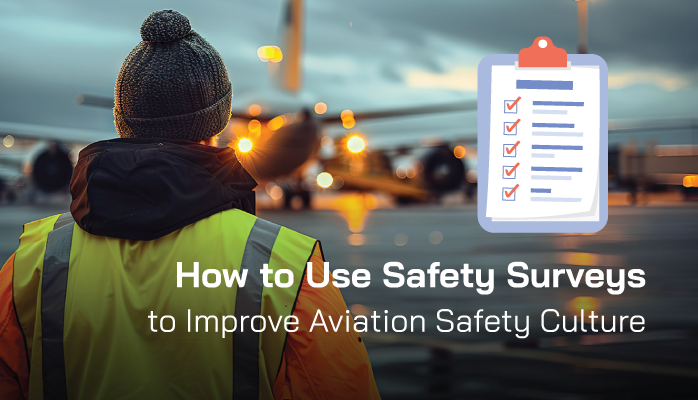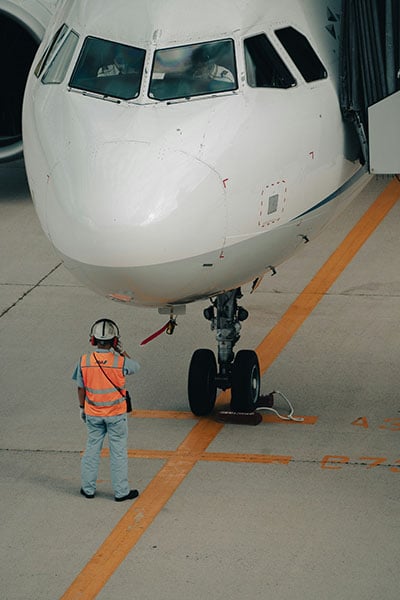Safety Survey Benefits Run Deep

Surveys seem a bit old-fashioned. That’s probably because they are.
Surveys have been around and popular for years. Safety surveys have many uses besides getting the opinions of the workforce. Surveys are also useful for
- Promoting the aviation safety management system (SMS);
- Teaching employees about processes or procedures;
- Confirming management's suspicions about employee behaviors.
Surveys are the ultimate information-gathering tool to determine how employees view the organization's aviation SMS.
- Do employees care about the SMS?
- How many employees completed the safety survey?
- What does your survey tell management about what to expect for safety performance?
These are questions an astute safety manager may already know, but cold, hard, truthful numbers are what the safety manager can take to top management to effect change. Imagine two scenarios:
In Scenario "A," a safety manager appears more credible saying, "Only 55% of employees bothered to respond to our safety culture survey, which leads me to believe our aviation SMS will become more effective once employees take ownership of the SMS and realize the benefits."
In Scenario "B," the safety manager may tell the accountable executive, "Employees really don't seem to care about our SMS. I get a feeling that we are losing money and operating with unnecessary risk because employees are not reporting safety issues. Something is holding us back from achieving our safety objectives, but I think it stems from employee attitudes."
As you can imagine, upper management would be more receptive to Scenario A, as the safety manager's assertions are based on actual analysis, instead of a gut feeling. As you can readily see, safety surveys can easily increase a safety manager's credibility when using statistics versus a "gut feeling."
Related Aviation Safety Survey Articles
- Aviation SMS Surveys - an Often Neglected Safety Promotion Tool
- 30 Good Questions for Safety Surveys in Aviation SMS [With Free Resources]
- 5 Characteristics of Effective Aviation Safety Cultures - With Free Survey
Multiple Uses of Aviation Safety Surveys
Because safety surveys seem old-fashioned, many organizations, while understanding that they are mandatory, tend to not take them very seriously – the result being hastily drafted, superficial questions.
When employees take aviation safety-related surveys that possess questions that aren’t thoughtful, one message tends to ring clear:
- Management doesn’t really value the employee’s opinion
On the other hand, of course, consistent and well-designed survey questions can be a real asset for any aviation safety manager. The real benefits of safety surveys go much deeper than simply checking in with employees and seeing how they are feeling.
They are one of the foremost tools to
- Gather quantifiable data;
- Educating employees; and
- Can also be used to subtly promote the aviation SMS.
Moreover, safety surveys open a forum for employees to give their honest – and anonymous – feedback about how a safety program is or is not functioning.
Safety Survey Provides an Open and Honest Forum

The most general benefit of doing aviation safety surveys is getting a sense of the organization's "safety morale”. In other words, you get an idea of how people are feeling. Knowing whether people are feeling–
- Frustrated
- Happy
- Apathetic
–about current safety practices is very useful for assessing employees’ level of resistance to change.
A more specific benefit that safety surveys provide is quantifiable data from a large audience. This is data that can be:
- Graphed to show current thinking/behavior
- Tracked over time to show trends in thinking/behavior
- Useful for showing improvement in various areas of the SMS
Because surveys are generally anonymous, safety managers can trust that their data is relatively free of bias. In many ways, this is one of the most compelling benefits of safety surveys – they allow a place for employees to be honest.
Modern usage of safety surveys in aviation SMS is generally intended to sample an organization's safety culture. How do employees feel about
- Management's commitment to safety? Is it earnest?
- The purpose of the SMS? Are they resistant, or accepting?
- Safety reporting system? Is it easy to use?
- The non-punitive reporting policy? Do they believe it?
Related Aviation Safety Culture Articles
- What Is Safety Culture in the Aviation Industry?
- How to Tell Your Safety Culture Needs Help? - With Aviation SMS Resources
- How Top Management Kills Your Aviation Safety Culture
Surveys Indirectly Promote Safety Culture
While subpar safety surveys can breed poor or apathetic safety morale, good safety surveys have the opposite effect. They promote a safety culture through engagement and concern.
Good safety surveys are thoughtful, engage relevant opinions, and ask “hard” questions such as “How well do you think management addresses your safety concerns.”
Surveys can send the message that:
- Safety is a top priority with management
- Employees’ honest opinions are valuable
- Employees are involved in the aviation SMS
- Employees are actively responsible for the management of the SMS
Moreover, safety surveys give employees an idea of the safety manager’s and management’s agenda. Employees get an idea of the types of safety issues that concern management.
When both management and the general workforce feel that they better understand each other, the road to transparency and cooperation is open. Trust is important to improve safety cultures. As management and employees learn to understand the motives behind other's agendas, trust increases with this understanding.
It’s commonly known as “bridging the gap.”
Safety Survey Best Practices

The most important part of any survey is the questions. When creating surveys, the bulk of the time should be spent working out the best, most relevant questions that will allow you to get the most accurate feedback about an SMS's performance.
This means asking hard and/or uncomfortable questions – questions whose data might indicate that the SMS is functioning far from optimally. Asking these types of questions can be daunting for an aviation safety manager, but they are necessary for the improvement of the aviation SMS.
After figuring out which questions to ask, surveys generally start with a safety survey template. Templates provide a framework for the organization, style, and length of the survey. All organizations have different SMS maturation levels and needs; therefore, each will need to adapt the template to fit their own particular needs.
Open-ended questions on surveys are difficult to track and quantify. Safety surveys should use one or a combination of the following answer types:
- Yes/no questions
- Scale (i.e. 1 to 5)
- Frequency-related (i.e. Never, Sometimes, Always)
First, this collected safety data is straightforward, easy to graph and track, and very quick for users to answer. Data that has discrete values becomes easier to collate and spot trends. Once you have collected survey results over multiple years using the same survey, you will have an opportunity to identify SMS performance monitoring trends. If you are just starting your SMS, don't expect to have enough collected data for useful trend analysis for at least three years.
The other critical element for conducting surveys that measure your safety culture always winds up being the question, how often should this particular survey be administered?
Related Aviation SMS Trend Analysis Articles
- Aviation Safety Managers' Best Friend - Trending Charts
- How to Use Trending Charts in Aviation SMS
- How to Prepare Data for Trend Analysis in Risk Management Programs
How Often Should Safety Surveys Be Conducted?
In many organizations, surveys are given out once per year. Conducting a yearly survey with the same questions helps establish long-term trends in general areas of an aviation SMS that a safety manager is most concerned with.
But surveys should be more frequent than that. Only conducting one safety survey per year does not:
- Allow for consistent safety promotion and employee involvement
- Offer more thorough data about particular aspects of an SMS
- Allow for trackable feedback about various SMS cultural changes
Provide surveys several times throughout the year:
- To get feedback about a particular past/upcoming change;
- For more educational purposes; or
- To identify trends that may be developing that go against the prescribed safety policy.
Note that if surveys are only given out when you notice undesirable behavior, surveys tend to feel more like a punitive measure than an inquiry into safety cultural issues.
The other benefits of conducting more regular surveys are:
- A subtle but consistent reminder of safety and transparency
- Keeps lines of communication between employees and management open
- Allows surveys to be shorter and easier to fill out than less frequent surveys
Especially for larger organizations with many employees, surveys are one of the best ways to get feedback from a pool of employees. Safety promotion is an often forgotten element in aviation SMS. This runs true in larger companies and those cultures outside Western cultures.
Practiced regularly and tactfully, surveys can be an effective safety promotion tool and facilitate breaking down resistance to the aviation SMS.
Related Aviation Safety Promotion Articles
- 4 Pillars | What Is Safety Promotion Component (the "Overlooked" Pillar)
- Effective Safety Promotion the Informal Way for Aviation SMS
- 3 Tips to Discover Resistance to Aviation Safety Program - With Checklists
Final Thought
Effectively using safety surveys provides valuable data and engagement in the areas of
- Creating just culture;
- Bridging the communication gap between management and employees; and
- Overcoming resistance to change – the areas safety officers struggle with the most in their aviation safety program.
Because safety surveys tend to be cliché, it’s easy to overlook how valuable safety surveys can be – and not many organizations utilize surveys to their full potential.
Although surveys are designed to be rigid and therefore quantifiable, that doesn’t mean that they can’t be employed in creative ways.
One of the most difficult challenges in conducting a safety survey campaign is creating a list of questions to ask. Here is some help. Many operators use these industry-accepted survey templates.
Last updated August 2025.







